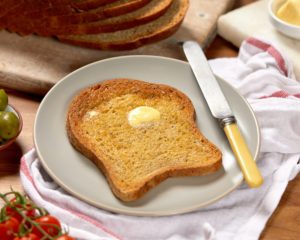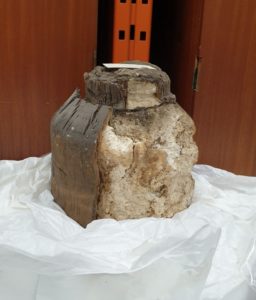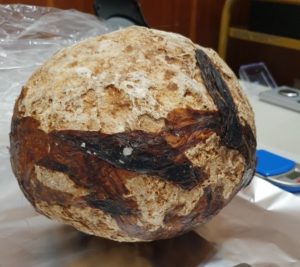
Photo by Seriously Low Carb on Unsplash
The archaeology of food and why bog butter is special
We eat food every day and, because our food is organic (i.e. from living things), the traces of the food we eat can disappear within months, weeks and even days. The material evidence of the toast you had for breakfast this morning will have all but vanished in two weeks’ time (except for its modern plastic packaging of course). This makes studying the food people ate in the past a challenge for archaeologists. The foods themselves rarely survive and, if they do, it is usually the raw ingredients rather than the meals themselves (such as plant seeds and animal bone). Enter to the stage bog butter, one of the weirdest and most wonderful archaeological finds. Bog butter is ancient butter that has been buried in peat bogs for centuries and even millennia. Ireland is home to the vast majority of bog butters, but they are also found in Scotland and Norway.
So, what actually is bog butter?

Bog butter in wooden vessel from Tyanee, Derry (BELUM.A481.1920). Reproduced with permission from the National Museum of Northern Ireland.
If we were being scientific, we’d describe bog butter as a mass of heavily degraded dairy lipids. In other words, big lumps of dairy fat – what we today call butter – that happen to be very old. It was made exactly the same way we make butter today, by churning the milk fat. But unlike modern butter which comes exclusively from cow’s milk, aDNA analyses of Irish bog butter suggest goat and sheep milks may have also been used.
When bog butter is first discovered, it has the lovely golden colour of fresh butter (like Kerrygold), as though it had only been made yesterday. You’d be forgiven for wanting to taste it, but trust me – you don’t! As the bog butter dries out, it grows paler and takes on a waxy or crumbly texture. It also starts to smell unpleasant. Think of the camembert cheese that stinks up your fridge with a smell that lingers for days even after its gone and you’re in the same ball park. However, that isn’t to say that bog butter was not eaten in the past. Records from the 17th and 18th centuries tell us the aroma of bog-aged butter was an acquired taste and desirable.
How long bog butter would have been buried for is a matter of debate. The oldest bog butter we know of so far comes from the Irish Bronze Age, over 4,000 years ago, while the youngest examples date to the 1600s. Did people in the past intend to age bog butters for over 4,000 years? Probably not. Historical records seem to suggest seven years was a good amount of time, but shorter periods of weeks or months would also be enough to preserve the butter for later consumption before fridges were invented.

Bog butter with remains of animal membrane covering (BELUM.A14643) from Garvaghy, Fermanagh. Reproduced with permission from the National Museum of Northern Ireland.
Why was it buried?
This brings us to the question of why bog butter was buried. For almost 200 years, archaeologists have puzzled over this question and there are many possible reasons. Bog butters could be ritual offerings to appease the gods. Or, people in the past could have been using the preservative properties of the bog to store the bog butter for times of need. Dairying was entirely seasonal in the past and in some places, like Ireland, it still is. Fresh milk, butter and cheese were plentiful in the summer, but absent in the winter so people needed to build up supplies to last them year-round. Bogs may have a smart and simple solution to this problem. If these bog butters were meant to be recovered, it raises the question as to why we find so many of them today, with over 670 in Ireland. These bog butters are not small either, with most weighing between 15-25 kg but some as large as 100 kg (so definitely not the same as the sticks of butter on supermarket shelves). I’m sure your family would not be impressed if you had buried so much of their butter in the bog and then lost it. So, were bog butters intended to be recovered? Are they all offerings to the land that happened to be preserved in the anaerobic environment of the bog? The truth probably lies somewhere in between. Some bog butters may have been offerings, other may have been buried for storage and lost or forgotten about. We should also remember that neither option is mutually exclusive. Burying butter in bogs for storage may have been accompanied by special rituals designed to protect it as it aged and the inability to recover it may have signalled the gods were unhappy with their fare.
So, why is bog butter cool?
Bog butter is cool for a lot of reasons. It is unique because it is the actual survival of large amounts of an ancient dairy product – something we can see, touch and smell. It also tells us about early farming – we know cows are important in prehistory, but bog butter allows us to see how goats and sheep had an important role to play too. Burying bog butter is also one of the longest practices in Irish history, showing a continuity of beliefs and traditions over extremely long periods of time. It also highlights the role of peatlands in the past and how they used to store so much more than just carbon. Dairy was and still is a staple food in Ireland and the survival of butter from thousands of years ago tells us our tastes haven’t changed very much. So next time you’re eating toast with butter for breakfast, just know that 4,000 years ago someone else was probably doing the same thing.
Last update: 18 July 2022







